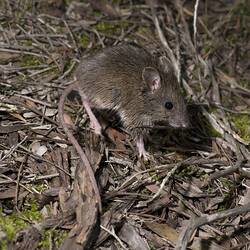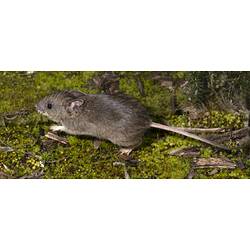General Description
Upperparts of fur are grizzled grey-brown. Underparts are greyish white. Tail is hairy and longer than the combined head and body length, and the upper surface of tail is darker than the under surface. Upper surfaces of feet are white. Body up to 9 cm, tail up to 11 cm. The New Holland Mouse has a more blunt face than the pointy-nosed House Mouse, Mus musculus and the tail is a different colour. The House Mouse smells very musky but the New Holland Mouse doesn't.
Biology
This threatened species is rare in Victoria and may have disappeared from many sites across the state where it was once recorded. The largest known population in Victoria is in the Gippsland Lakes area. The New Holland Mouse depends on an optimal level of habitat disturbance and does not maintain large populations in mature or heavily disturbed habitats. Population densities fluctuate seasonally and with habitat disturbance, usually peaking a few years after a fire. These mice are active at night and spend the days in communal, underground burrows.
Distribution
Patchy distribution in primarily coastal habitats of Victoria, Tasmania, New South Wales and southern Queensland.
Habitat
Heathland, woodland and open forest habitats. Prefers recently burned or other naturally disturbed habitats.
More Information
-
Animal Type
-
Animal SubType
-
Brief Id
Mouse with grey-brown upperparts and grey-white underneath with a hairy tail longer than head and body, white feet.
-
Maximum Size
10 cm
-
Habitats
-
Diet
Herbivore
-
Diet Categories
Seeds
-
Endemicity
-
Commercial
No
-
Conservation Statuses
CITES: Not listed, FFG Threatened List: Endangered, EPBC Act 1999: Vulnerable, IUCN Red List: Vulnerable
-
Taxon Name
-
Common Name
New Holland Mouse
-
Kingdom
-
Phylum
-
Subphylum
-
Class
-
Subclass
-
Order
-
Family
-
Subfamily
-
Genus
-
Species Name
novaehollandiae





